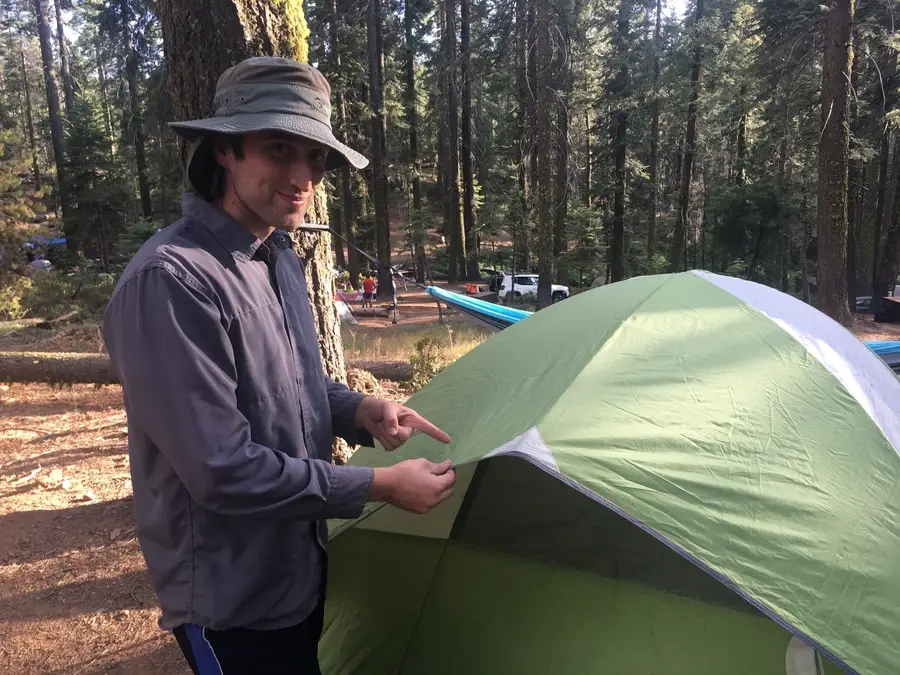
Have you ever wondered if a rain fly will keep your tent warmer? I have, and so I had to do some research to find out if it does because when you are out tent camping on a cold night you want to utilize everything you can in order to stay warm. On cold nights I always put my rain fly on because I figured it would make it a little warmer inside my tent. I did some formal research and put together all of my findings here so you too can know the answer to the question “does a ran fly keep a tent warmer?”
So, does a rain fly keep a tent warmer? A rain fly will provide a small amount of warmth compared to there being no rain fly at all. This is primarily achieved by reducing wind chill.
Don’t count on a rain fly to make a significant difference in keeping you warm, you need to be prepared with other gear to really keep you warm.
By the way, If you are in the market for a new tent, then you should click here to see the one I recommend on Amazon.
Rain Flys Reduce Wind Chill
Wind chill is simply the lowering of your body temperature due to cold air passing by your body. Wind chill is the reason why days with a breeze feel colder than stagnant days even if the temperature is the same. Putting your rain fly on your tent will help reduce this wind chill if it covers the mesh openings of your tent. If your tent also has zip windows, then it is best to keep those closed as well to prevent excess air from getting into the tent.
Having a cold wind brush against your body will make the temperature feel significantly cooler. That is why most online weather reports will include a “feels like” temperature in order to account for the wind chill. The rain fly will reduce wind chill, but it will not eliminate it completely because tents are designed to allow air to pass through it. This not only helps it sustain its structure in high winds but also allows for proper ventilation.
A fun experiment you could try if you want to test out how much of a difference your rain fly has is to bring two thermometers and place one inside of your tent and one just outside of it and compare the two readings. Not only does the rain fly reduce the wind chill, which the thermometers won’t be able to properly read, but the tent can also trap some warmth that you generate inside of it.
Rain Fly’s Trap Some Warmth In Your Tent
Tents are a shelter that helps protect you from the elements, but they aren’t exactly designed to maximize insulation. However, a tent can trap warmth inside of itself at least temporarily. When you are moving around inside of the tent your body is generating heat and the tent will hold onto that heat for a very short while if you have the rain fly on and everything zipped up. Eventually, it will dissipate naturally because of the tent is designed to ventilate.
This is in part why you shouldn’t really rely on a rain fly to provide any significant warmth throughout the night. The trapping of heat and raising of the internal temperature of the tent works a lot better with smaller tents because the heat has less space. Still, it will be vented out by your tent. You shouldn’t be worried about this however because the ventilation serves a very important purpose.
Even though the warm air gets vented out, it is to your benefit because it will reduce condensation build-up inside the tent. This is very important for staying warm because condensation and moisture will make your body cold. In fact, having anything that is already damp inside of your tent can cause condensation to build up inside of it. The good news is that a good rain fly and a good tent should keep the condensation from dripping inside of your tent if there is proper ventilation.
You might be tempted to put something on top of your tent in order to prevent more airflow, but I would advise against it because it is just asking for more condensation build up inside of the tent. Even if you keep everything damp outside of your tent, by simply breathing you are putting moisture in the air. Breathing is something we cannot prevent, so it is better that it gets properly vented out. Being wet from condensation is not going to help you stay warm, what will is being prepared and having other proper gear to stay warm.
Don’t Count On A Rain Fly To Actually Keep You Warm
Now we know that the rain fly will help with warmth very slightly, but not enough to make a big difference, and so we shouldn’t rely on that to keep us warm. What we need in order to stay warm is some good gear. There are some basics that we can utilize to guarantee that we will be warm enough to make it through even the coldest of nights:
Sleeping Bag
Having a high-quality sleeping bag that is rated well enough for the temperatures that you will be sleeping in is essential to staying warm enough. Even having a sleeping bag that is rated below what you will be using it for is still better than having one that is not rated low enough because you can always unzip part of the bag and let some hot air vent out. You could also unzip it all the way and use it as a blanket on warm nights where it isn’t necessary to be bundled up. If you are going to be in really cold weather then consider getting a mummy sleeping bag because they are well known for being the best bags for really cold weather.
Sleeping Pad
Having a good sleeping pad is a lot more useful for staying warm than you might initially think. A lot of heat can be lost through the floor and a good sleeping pad designed to prevent that heat loss will make a world of a difference in cold weather. Using a regular air mattress won’t be able to offer you proper insulation because the air inside of it gets very cold and there is almost no layer between your sleeping bag and the cold air inside of the mattress. Luckily you can have the best of both worlds if you first put down an air mattress and then put down a nice insulated sleeping pad on top of it.
Warm Clothing
Warm clothing will make all the difference if you want to stay warm. Start with something that will keep your head warm. Although you don’t lose nearly as much heat as the old myth goes of losing half of your heat through your head, we still want to reduce heat loss as much as possible. After you got your head covered, think about getting some thermal layers that are tight to the body, they are great for keeping your body heat trapped against you.
Next, move on to your feet because cold feet can make for an uncomfortable night’s sleep. Choose fabrics that are moisture-wicking, one of the best you can get is wool. What you don’t want to do with all this clothing is get too warm and start to sweat at night because that will cool down your body, but it might cool it down too much. If you are too warm then it is better to remove some layers so that you are not sweating in the middle of the night.
There are lots of other options you can utilize to stay a little bit warmer but the main ones you want to focus on first are having a good sleeping bag, having a good sleeping pad, and wearing the appropriate clothing.
Conclusion
While a rain fly will keep you a little bit warmer by reducing wind chill, and trapping some heat, you shouldn’t rely on it to provide any significant warmth. If you are worried about staying warm you need to start with having the right gear. The best place to start is with your sleeping bag, sleeping pad, and clothing.
My Favorite Camping Gear
- Air Mattress: click here
 to check out my favorite on Amazon.
to check out my favorite on Amazon. - Tent: click here
 to see my favorite tent available on Amazon.
to see my favorite tent available on Amazon. - Sleeping Pad: click here
 to check out the one I love on Amazon.
to check out the one I love on Amazon. - Sleeping Bag: click here
 to see the one I recommend on Amazon.
to see the one I recommend on Amazon. - Camping Stove: click here
 to see the best camping stove on Amazon.
to see the best camping stove on Amazon.

